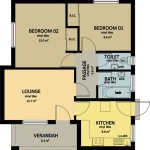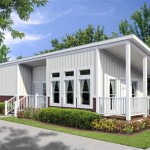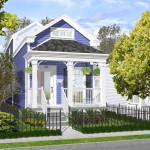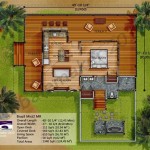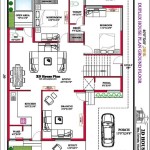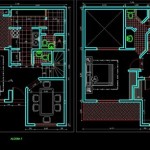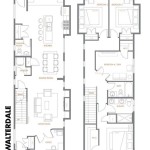Contemporary Inverted House Plans: Free Printables for Beginners
The concept of an inverted house plan, also known as a reverse living plan, presents a compelling alternative to traditional home design. Instead of the conventional layout with living spaces on the ground floor and bedrooms above, an inverted house prioritizes the common areas, such as the living room, dining room, and kitchen, on the upper level. The bedrooms and private spaces are situated on the ground floor. This design philosophy is particularly advantageous for properties with desirable views from the higher elevations or those seeking enhanced natural light and ventilation.
The allure of an inverted house plan extends beyond aesthetic appeal. It offers functional benefits related to energy efficiency, privacy, and overall lifestyle. These advantages have fueled the increasing interest in inverted house plans, particularly among those seeking modern, adaptable living spaces. For beginners venturing into home design, accessing free printable resources can be invaluable in understanding the complexities and potential of this architectural style.
This article aims to provide a comprehensive overview of contemporary inverted house plans, focusing on the availability and utilization of free printable resources for individuals new to the concept. It will explore the key features of inverted house plans, the benefits they offer, and how beginners can leverage free printables to embark on their design journey. The article will also cover critical considerations in adapting and customizing these plans to meet specific needs and site conditions.
Understanding the Core Principles of Inverted House Plans
The fundamental principle behind an inverted house plan is the reversal of the traditional floorplan layout. Instead of entering the house and immediately encountering bedrooms or a foyer leading to private spaces, the entry level typically houses the bedrooms, bathrooms, and potentially a home office or secondary living area. The upper level is dedicated to open-concept living spaces, including the kitchen, dining area, and living room. This arrangement is often accompanied by large windows and outdoor decks or balconies to maximize views and natural light.
Several factors contribute to the effectiveness of an inverted house plan. One crucial element is the strategic placement of stairs or an elevator to provide convenient access between the levels. The design must also consider the flow of traffic and ensure that the separation between private and public spaces is well-defined. Soundproofing between floors becomes particularly important due to the proximity of living spaces and bedrooms.
The orientation of the house on the property is critical. An inverted house plan benefits significantly from being situated on a site that offers desirable views from the upper level. This could include panoramic vistas of natural landscapes, city skylines, or waterfront settings. The plan should capitalize on prevailing wind patterns to optimize natural ventilation and reduce reliance on artificial cooling systems. Solar orientation is another key consideration, as the larger windows on the upper level can be strategically positioned to maximize solar heat gain in winter and minimize it in summer.
Benefits of Inverted House Plans
Inverted house plans provide a multitude of benefits that contribute to enhanced living experiences. One of the primary advantages is the maximization of views. By placing the main living areas on the upper level, residents can enjoy unobstructed perspectives of the surrounding environment. This design is especially suitable for properties located on hillsides, near bodies of water, or in areas with significant natural scenery.
Another significant benefit is improved natural light and ventilation. Upper-level living spaces often receive more sunlight and are exposed to better airflow. This can lead to reduced energy consumption for lighting and cooling, creating a more sustainable and comfortable living environment. Large windows can be strategically placed to capture sunlight throughout the day, while cross-ventilation can be optimized by incorporating windows on opposite sides of the upper level.
Enhanced privacy is another advantage offered by inverted house plans. By locating the bedrooms on the lower level, they are shielded from street-level noise and activity. This creates a more peaceful and private sleeping environment. Additionally, the lower level often provides direct access to outdoor spaces, such as a garden or patio, offering a private retreat for residents.
Finally, inverted house plans can be more adaptable to changing lifestyles. The open-concept living spaces on the upper level can be easily reconfigured to accommodate different needs and preferences. This flexibility makes inverted house plans suitable for families of all sizes and those who enjoy entertaining guests. The lower level can be adapted to serve as a guest suite, a home office, or a recreational area as needed.
Utilizing Free Printable Resources for Inverted House Plans
For beginners interested in exploring inverted house plans, free printable resources can be invaluable tools for learning and experimentation. These resources often include sample floor plans, design templates, and detailed diagrams that illustrate the key features of inverted house plans. They can be used to gain a better understanding of the spatial relationships and functional considerations involved in this type of design.
Several online platforms and architectural websites offer free printable resources for inverted house plans. These resources vary in complexity and detail, ranging from simple sketches to comprehensive blueprints. It is important to carefully evaluate the quality and accuracy of these resources before using them as a basis for design decisions.
One effective way to utilize free printable resources is to use them as a starting point for brainstorming and conceptualizing different design options. Beginners can experiment with different layouts, window placements, and material choices by modifying the printable plans. This hands-on approach can help them develop a deeper understanding of the design principles and spatial considerations involved in creating an inverted house plan.
Another valuable application of free printables is to use them as a communication tool with potential contractors or architects. Presenting these plans can convey specific design ideas and requirements, facilitating a more productive and collaborative design process. Having a visual representation of the desired outcome can help ensure that the final design meets the expectations and needs of the homeowner.
Adapting and Customizing Free Printable Plans
While free printable inverted house plans can be a helpful starting point, it is important to recognize that they may not be suitable for every site or lifestyle. Adapting and customizing these plans is often necessary to ensure that the final design meets the specific needs and preferences of the homeowner. This process may involve modifying the floor plan, adjusting the dimensions of rooms, or changing the location of windows and doors.
One important consideration when adapting a free printable plan is the orientation of the house on the property. The plan should be adjusted to maximize solar exposure, optimize natural ventilation, and take advantage of any existing views. This may involve rotating the house or reconfiguring the window placements to capture the best light and ventilation conditions.
Another key consideration is the size and shape of the property. The printable plan may need to be scaled up or down to fit the available space. It may also be necessary to adjust the shape of the house to accommodate irregular lot lines or existing site features. Working with a qualified architect or designer can be helpful in navigating these challenges.
Customizing the interior layout is also crucial to ensure that the house meets the specific needs of the occupants. This may involve adding or removing walls, relocating bathrooms or kitchens, or creating specialized spaces such as a home office or a gym. It is important to carefully consider the flow of traffic and the functional relationships between different rooms when making these adjustments.
Critical Considerations in Inverted House Plan Design
Designing an inverted house plan involves several critical considerations that must be addressed to ensure a successful outcome. One of the most important is the accessibility of the upper-level living spaces. Stairs are typically required to access the upper level, but it is important to ensure that they are designed to be safe and comfortable for all occupants. This may involve incorporating handrails, providing adequate lighting, and ensuring that the stairs are not too steep or narrow.
For individuals with mobility limitations, an elevator or lift may be necessary to provide access to the upper level. This adds to the cost of the project, but it can significantly improve the accessibility and usability of the house. It is important to factor in the space requirements for an elevator or lift when designing the floor plan.
Another critical consideration is soundproofing between the floors. Because the bedrooms are located directly beneath the living spaces, it is important to minimize noise transmission between the floors. This can be achieved by using sound-absorbing materials in the floor assembly and by incorporating soundproof doors and windows. Careful attention to detail in construction is essential to ensure that the soundproofing is effective.
Finally, it is important to consider the exterior aesthetics of the house. The design should be visually appealing and harmonious with the surrounding environment. The placement of windows, doors, and balconies should be carefully considered to create a balanced and attractive facade. The choice of materials and colors should also be carefully selected to complement the overall design and the surrounding landscape.
In conclusion, contemporary inverted house plans offer a unique and compelling alternative to traditional home design. By placing the main living spaces on the upper level, these plans maximize views, improve natural light and ventilation, and enhance privacy. While free printable resources can be invaluable tools for beginners exploring this design style, it is important to carefully adapt and customize these plans to meet the specific needs and site conditions of each project. By considering the critical design considerations discussed in this article, individuals can create an inverted house plan that is both functional and aesthetically pleasing.

Inverted Living Contemporary Style House Plan 7884

Home Ideas 610 Inverted House Plans

Inverted Living Contemporary Style House Plan 7884

Arrow House Plan A Modern Skinny Two Story Home Design Mm 1163

Two Story Contemporary Style Reverse Living House Plan 9974 Shiloh

Freedom 25 Simple Small Modern House Plan By Mark Stewart

Riverside Farmhouse Modern House Open Plan Design 3 Bed 2 5 Bath Car Drawings Blueprints

The Contemporist Sloping Lot Modern Style House Plan 4282

Beautiful Contemporary Style House Plan 4270 The Pelosa

Pendleton House Plan Most Popular Modern Farmhouse Home Design Main Floor Primary Mf 2639

